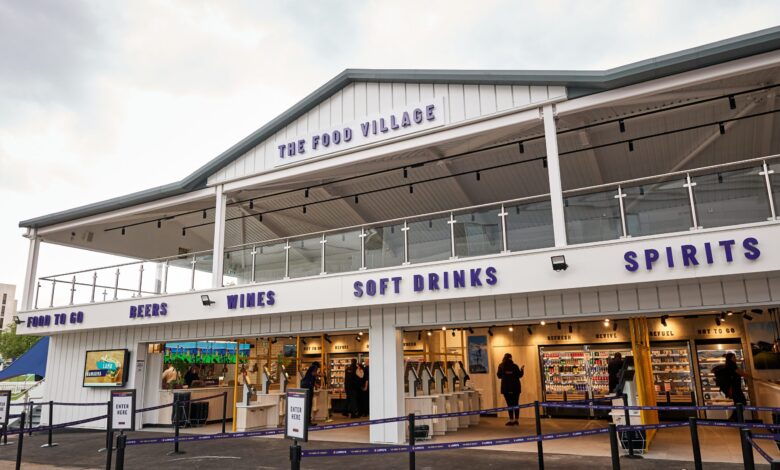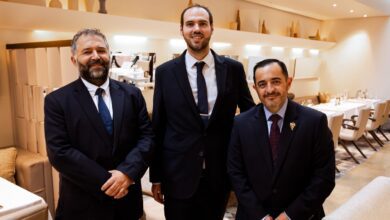Extra covers: The technology driving Freeman’s new Lord’s Food Village
Catering Today explores the new Food Village from Freeman’s Event Partners at Lord’s Cricket Ground, including how it was built, the challenges involved and what it tells us about the future of stadium catering

Register to get 1 free article
Reveal the article below by registering for our email newsletter.
Want unlimited access? View Plans
Already have an account? Sign in
Freeman’s Event Partners has just put the finishing touches on a brand new Food Village at Lord’s Cricket Ground. For the company which is accustomed to catering large events and sports stadiums this is a big step forward with a permanent venue.
The way the Village has been constructed can tell us a lot about where the large-scale catering industry stands and the future of it, the challenges behind creating a large permanent base and why AI is not the silver bullet solution for catering.
Constructing a permanent base
The new Food Village at Lord’s is a two floor structure with a large outdoor area. It incorporates a number of different cuisines and offers freshly cooked food as well as grab and go food on the ground floor.
The freshly cooked food includes; fish and chips, fried chicken and burgers as well as more exotic foods such as Korean style beef bao buns and chicken tacos alongside a number of vegan options.
A permanent structure in what is a fairly confined space at the more than 200-year-old cricket ground comes with unique challenges. As Simon Hanna, Freeman’s COO explains, building a structure at Lord’s is no mean feat. “When it comes to installing a permanent structure, like the new Food Village at Lord’s Cricket Ground, it’s important to optimise the space to really maximise the impact it’s going to make.
“The last thing a venue wants is ‘dead’ space, so it’s vital that the structure is planned with the most efficient layout possible in order to maximise trade and provide an enhanced guest experience. It is also key to work with the local council and understand potential hindrances to planning applications, it helps avoid a lot of going back and forth and delays to the building process.”
Lord’s is also unique as it is owned by members of the Marylebone Cricket Club which in itself adds another set of stakeholders who must be satisfied with whatever plans Freeman’s tried to accomplish. It also hosts a number of different events which cater to different audiences. The crowd at an England test match will not want the same things as the crowd at a Middlesex T20 Blast game and that had to be taken into account.
“When you’re going from a temporary structure, with 50 different temporary units, and trying to make it one fixed unit, you have to consider what you’re moving away from. We need to serve food, we need to serve alcohol and we need to serve soft drinks and get that whole demographic right, especially in such a prestigious setting as Lord’s, where the demographics are so diverse.
We have to get the food offer right, the drink offer, alcohol, 0% and you’ve got Test matches that are five days and you’ve got the Hundred which is really a family evening event, so the challenge is to try and cater to everyone,” says Hanna.
AI dismissed
An interesting feature of the new Food Village is the fact that Freeman’s declined to incorporate any AI technology into it. With AI being the newest tech on the block it would be easy to imagine a world where the company felt they had to include it in their flagship offering. Freeman’s could have elected to use technology similar to Amazon Fresh in its grab and go section to speed it up even more.
However, the Freeman’s believed that this was never really an option simply down to cost and return on investment. The cost of implementing AI can be prohibitive and the returns can be negligible. Plus, as seen with Amazon Fresh, the technology is not quite as advanced as many companies would have you believe. That being said, Freeman’s has not ruled out implementing it in the future.
“New technologies require a high level of investment and as with all new tech, the evidence available that demonstrates ROI and improvements to the fan experience are limited. Venues and events may feel that deviating from more tried and tested methods is unnecessary and expensive.
“In reality, it’s a way to future-proof the guest experience and bring it in line with other sectors, such as retail and leisure, where technology is far more advanced. Joint partnerships are a way to overcome those challenges where partners can share the initial capital investment and the results then become mutually beneficial,” Hanna stated.
The wider future
This then begs the question what actually is the future of catering at large events and how much of it can be seen at this new Food Village. According to Foodservice Consultants Society International ventless technology has changed the game. These easy-to-install set-ups use an ozone filtration system to remove fats, oils and grease from the airstream while also removing cooking odours. They can be set up anywhere in an arena with an electrical outlet and plumbing. Some operators are dividing their facilities up into quadrants to ensure fans can be served more quickly. In some situations, this will mean four carbon copy F&B offers.
And this has meant that stadiums have been able to vary their food offerings by turning what would previously have been dead space into another point of service, something that Freeman’s has done at Lord’s.
With sports events and days out becoming ever more expensive, and with the costs of running something like this Food Village ever increasing, Freeman’s is committed to making sure the quality of the output is well worth the price for the consumer.
“It’s all about the fan experience. Now, the days of worrying about price and profitability are still there, but we all charge a premium for our tickets. We charge a premium for our beer. We have to make the fan experience better. It has to be slicker, it has to be quicker, It has to be more effective, has to be more varied, and also has to be very sustainable,” says Hanna.
“People have come to associate events with great food and drink, and they look forward to this just as much as the event itself. Things like self-serve and AI will be integral to the future landscape of catering at events and stadia, ensuring that guests can get food and drink in their hands as quickly as possible, eliminating long queues and big crowds.
“In addition, it is key for venues and events to consider how they can mirror the experience fans have at home with the ability to watch replays and socialise with friends in an event setting, this will be key to increasing spectator numbers. We have an opportunity to fully integrate food and beverage to the fan experience and are looking to build more permanent fan zones where spectators can do just that before or after a match; thus, increasing dwell-time and ultimately the spend per head, and enabling venues to secure their future,” Hanna added.







